Adobo: Verb, Noun or Adjective Part 1

Language and parts of speech always fascinate me. I look at words with multiple meanings and get caught up in how they are used in a sentence or how to put action to the word. This interest started early in grade school when the discovery was made that my sisters and I could use our last name three times and make a complete sentence. Barbara Felt felt felt. My name was the proper noun, the second felt was a verb and the third was the noun. (My sister Mary is reading this right now screaming that she made this discovery so I will give her credit for this linguist phenomena.)
Last month, that childlike whimsy came back to me when I found some recipes for adobo. I’m the most familiar with the adobo that one finds in a can for Mexican cooking (I’ll write more about that in Part 2) but was not familiar in adobo, the cooking method.
The Adobo Process
The definition that came up first was adobo: a cooking technique that has been a staple of the Philippines for centuries.
The simplest description would be that adobo is the practice of marinating and simmering meat in vinegar. (Garlic, soy and variety of different spices all came along in the development as other countries came to the islands and influenced the recipes.)
It all started back in the days before refrigeration when vinegar was used to preserve meat, making it safer to eat. The meat would simmer in the vinegar marinade. As the vinegar cooked down it created a pure rounded out acidic but smooth sauce. The result is really a unique flavor because it isn’t that typical brightness you get from an acid or the sour that makes your cheeks hurt. It pulls it all together so that it is balanced. The moisture in the heat breaks down the meat so the result is fork tender and delicious.
As I was reading about adobo, I was making another discovery that there are as many different varieties of adobo as there are islands in the Philippines. (For the record, there are over 7000 islands which translates to a lot of different adobo recipes.) Similar to how different parts of the United States would make something like chili or regions of Italy all make a “red sauce,” the adobo recipes were less about specifics and more about understanding the technique of achieving what I can only describe as greatness.
Ask an Expert
I ended up calling one of my favorite Chicago chefs, Kristine Subido (Director of Culinary at LinkedIn and also the genius behind The Pecking Order and the spice company Peckish) to help me understand something that essentially was larger than I would have ever guessed. Besides the fact that she is a wonderful chef, Kristine hails from Manilla in the Philippines. She grew up at the apron strings of wonderful cooks learning in a country that had culinary influences from all over the world.
Adobo History
As Chef Subido told me, adobo is derived from the Spanish word Adobar which means to marinate. The story goes that in the 1500s when Spain colonized the Philippines, the Spanish word adobo was accepted as a common term for everyone to use to explain this approach of preservation, marinating and cooking. The resulting food that is cooked by this method is called adobada.
You can marinate a meat but only the vinegar and salt-based marinated dishes are considered adobo. With influence from China, soy sauce has also become the common salty ingredient in the marinade process. The salty component as we know from pickling in salty brines helped in the preservation of the proteins and became quite common.
In addition, I wasn’t kidding when I talked about variations. In the southern regions coconut milk is used in the recipe. A recipe with no soy is considered white adobo and seems like the most classic version of the dish to me. I also found recipes that included sugar. A few ingredients may vary but they all had vinegar and they all use the marinade as a cooking liquid.
While talking to Chef Subido, it became abundantly clear that adobo can be considered a cultural phenomenon. When we see dishes evolve or discuss food fusion, I would say that adobo is probably one of the earliest and tastiest examples of Asian fusion.
Chef Subido also pointed out that Filipino chefs/restaurants are being recognized more these days because they “unapologetically use techniques” that can really showcase the wonder that has been part of Filipino food history for centuries. (By the way, Chicago is home to America’s only Michelin Starred Filipino Restaurant, Kasama, which is a favorite of our Chef Max.)
Adobo: Philippines vs Spain
Given the Spaniards already had the word “adobo” in their vocabulary to explain marinating meat, there were definitely some Spanish recipes that made adobo just like the Filipinos but with the addition of paprika. The use of vinegar and a less aggressively pungent species of capsicum like paprika would result in a tasty, well-preserved meat.
To understand food, we must prepare it or at least that is my thought. So, I did just that. I cooked chicken thighs two ways with only a slight variation in ingredients:
Classic Filipino Adobo Spanish Style Adobo
White Vinegar Sherry Vinegar
Garlic Garlic
Peppercorns Paprika
Soy Sauce Salt
Bay Leaves Oregano
Here are the two dishes side to side. (Recipes can be found below.)
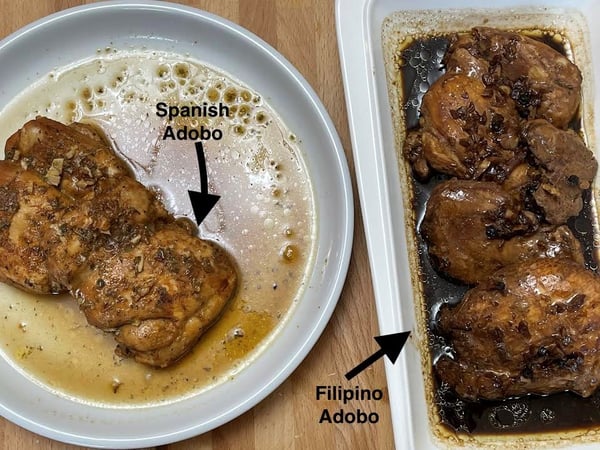 Given this was my first attempt at either adobo, the results were amazing. Look at how similar they look. The Spanish adobo was obviously a bit smokier tasting due to the paprika. The Filipino version had that umami punch with a bit of a tang that makes one feel like they landed on their own private island of culinary joy. The similarity was how the vinegar reduced and the gentle simmer cooked the meat. They were identical in that description.
Given this was my first attempt at either adobo, the results were amazing. Look at how similar they look. The Spanish adobo was obviously a bit smokier tasting due to the paprika. The Filipino version had that umami punch with a bit of a tang that makes one feel like they landed on their own private island of culinary joy. The similarity was how the vinegar reduced and the gentle simmer cooked the meat. They were identical in that description.
The Big Question
In this definition, adobo can be defined more as a verb because this type of adobo is an action not an exact flavor. The big question is how is adobo a noun or adjective too? Subscribe to The Chopping Blog on the top right of this page to make sure you don’t miss the exciting conclusion of this riveting revelation! (I love a good summer cliffhanger!)
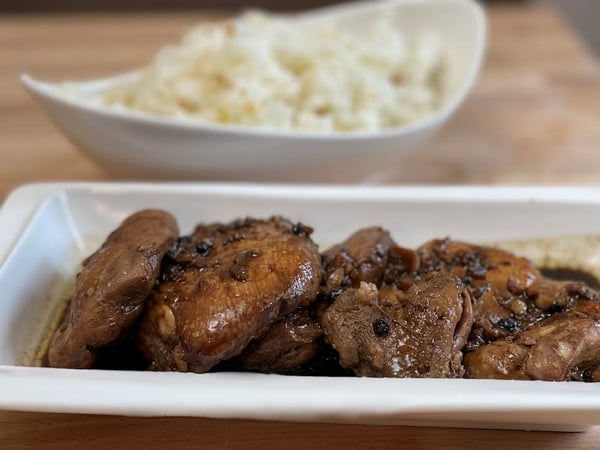
Filipino Adobo
Scroll down for a printable version of this recipe
Serves 2-3 with a side of rice
Prep time: 5 minutes
Inactive time: 1-6 hours for marinating (You can even do it overnight.)
Cook time: 30-40 minutes
Total time: 2 hours, minimum
1/4 cup soy sauce*
1/2 cup white vinegar*
3 teaspoons chopped garlic
1 teaspoon of whole peppercorns
3 bay leaves
1.5 pounds of chicken boneless, skinless chicken thighs
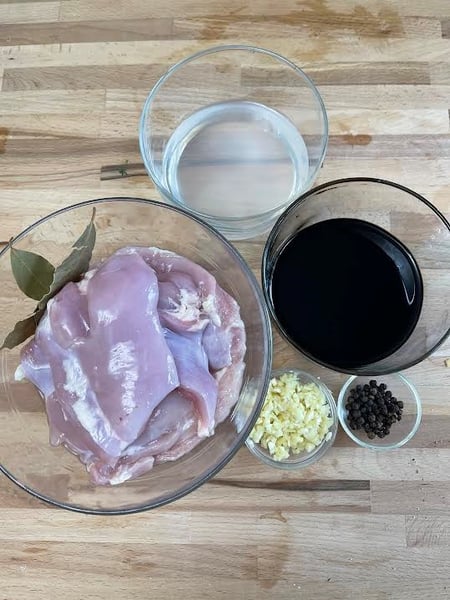 *Note: I purchased a Filipino soy sauce and white vinegar. The taste was a bit different than traditional soy sauce. The white vinegar had a little cloudiness to it and had a really pleasant aroma to it. Don’t feel you can only make this with Filipino sourced products. If you feel like experimenting, use your pantry favorites.
*Note: I purchased a Filipino soy sauce and white vinegar. The taste was a bit different than traditional soy sauce. The white vinegar had a little cloudiness to it and had a really pleasant aroma to it. Don’t feel you can only make this with Filipino sourced products. If you feel like experimenting, use your pantry favorites.
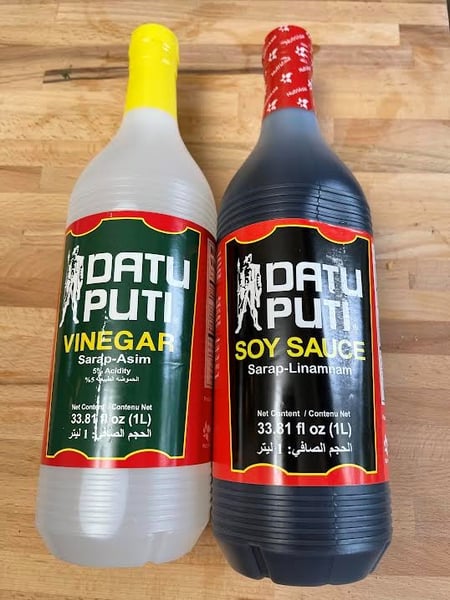 1. In a glass bowl, mix soy, vinegar, garlic, peppercorns, bay leaves and chicken thighs. Make sure the chicken thighs are all coated.
1. In a glass bowl, mix soy, vinegar, garlic, peppercorns, bay leaves and chicken thighs. Make sure the chicken thighs are all coated.
2. Cover and marinate for at least an hour in the refrigerator.
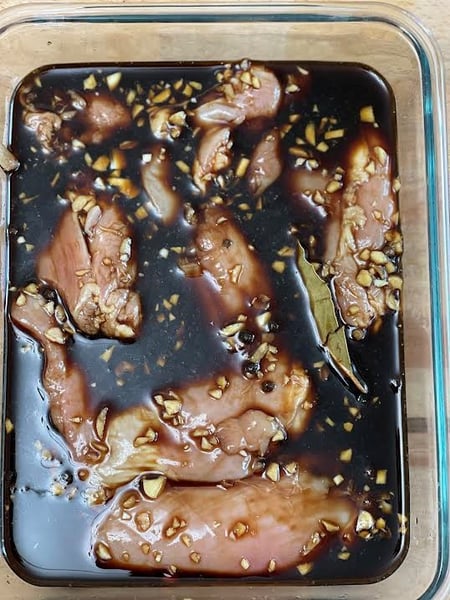 3. Heat a large non-reactive pot over medium high heat. Heat a generous swirl, about 1 Tablespoon, of oil.
3. Heat a large non-reactive pot over medium high heat. Heat a generous swirl, about 1 Tablespoon, of oil.
4. Remove chicken from marinade and shake off excess liquid.
5. Sear both sides for about 1-2 minutes. You are going for a little bit of brown. Don’t worry about it cooking all the way through because this is just for color and flavor.
6. In that same pan with the chicken, add the rest of the marinade. Bring to a consistent simmer and then cover for about 25 minutes.
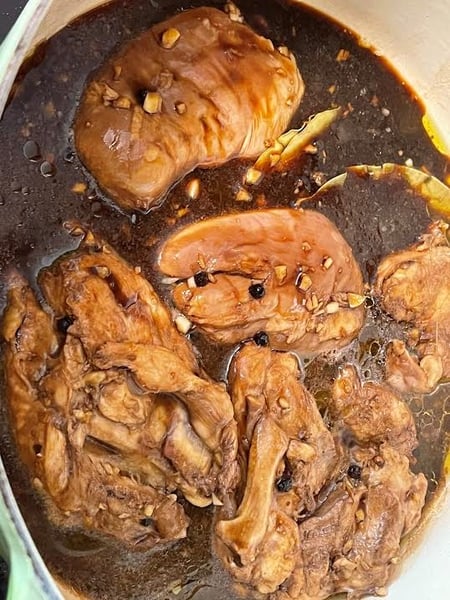 This is how my chicken looked after 20 minutes. I flipped my chicken and cooked another five minutes. I used a fork and broke off a piece to see that it was done.
This is how my chicken looked after 20 minutes. I flipped my chicken and cooked another five minutes. I used a fork and broke off a piece to see that it was done.
7. With the lid off, allow to continue to simmer until the sauce reaches your desired consistency. Also take a taste. If you would like the vinegar to shine through more, add a little bit more. This is also where I saw recipes add sugar for those who desired a sweeter adobo. Some people like a wet adobo so they can spoon copious amounts of sauce over their chicken and rice. Others like a dry adobo where the sauce almost becomes syrupy from reduction. This is where centuries of family developed recipes really come in handy.
8. Remove the bay leaves before serving. Don’t worry about the whole peppercorns. They mellowed out greatly with the long marinade time and cooking.
9. Serve with a bowl of rice.
For my next go around, I will use Chef Subido’s suggestion of 1.5 parts vinegar to 1 part soy sauce. And I owe her big thanks! From the first time I met her, she has encouraged my own exploration and growth by sharing her roots and her expertise. She is a gem.
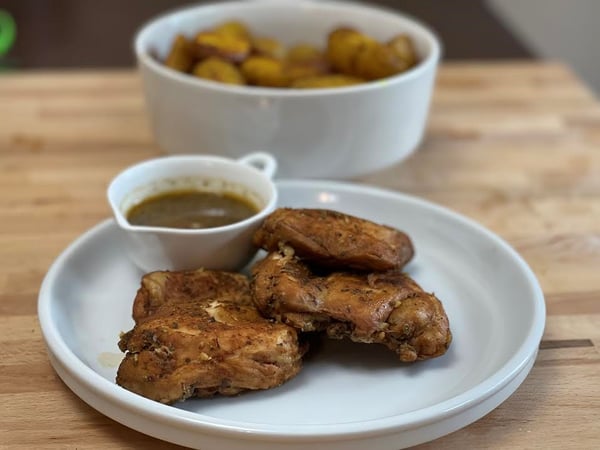
Spanishish* Chicken Adobo
Serves 2-3
Prep time: 5 minutes
Inactive time:1-6 hours for marinating (You can even do it overnight.)
Cook time: 30-40 minutes
Total time: 2 hours, minimum
*Note: This marinade in this recipe was on a notecard in my files called "Spanishish Chicken". I took the liberty of calling it adobo and cooking it adobo given the methodology was the exact same as what I had learned about this past month.
1/3 cup sherry vinegar
3 teaspoons chopped garlic
1 teaspoon spicy paprika
2 teaspoons sweet paprika
2 Tablespoons of Mexican oregano
1 cup chicken broth (I was really concerned that my vinegar would evaporate too quickly so the addition of the broth seemed appropriate.)
1.5 pounds of chicken boneless, skinless chicken thighs
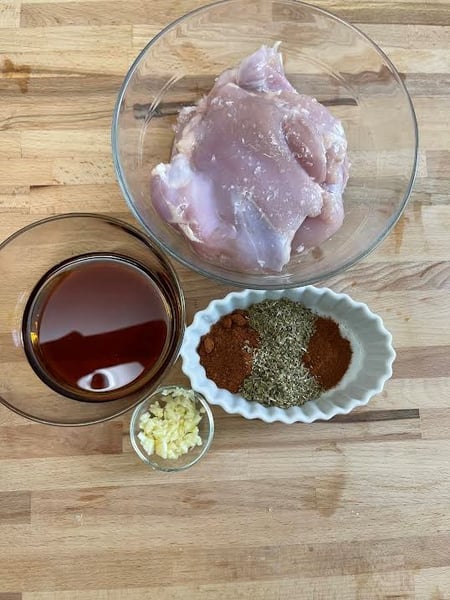
1. In a glass bowl, whisk together vinegar, garlic, oregano, and paprika.
2. Coat the chicken thighs, cover and marinate for at least an hour in the refrigerator.
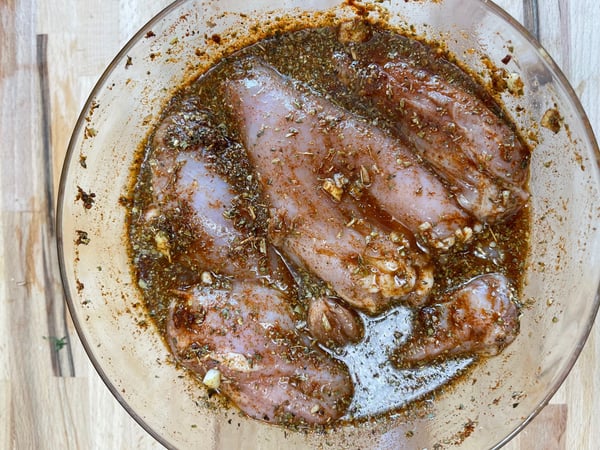 3. Heat a large non-reactive pot over medium high heat. Heat a generous swirl, about 1 Tablespoon, of oil.
3. Heat a large non-reactive pot over medium high heat. Heat a generous swirl, about 1 Tablespoon, of oil.
4. Remove chicken from marinade and shake off excess liquid.
5. Sear both sides about 1-2 minutes. You are going for a little bit of brown. Don’t worry about it cooking all the way through because this is just for color and flavor.
6. In that same pan with the chicken, add the rest of the marinade and the chicken broth. Bring to a consistent simmer and then cover for about 25 minutes.
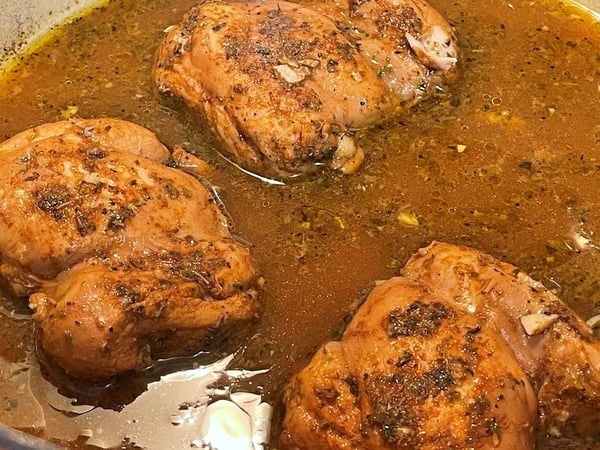 7. With the lid off, allow to continue to simmer until the sauce reaches your desired consistency. Also take a taste. This did not reduce as syrupy as the Filipino adobo, but the sauce that resulted was absolutely divine.
7. With the lid off, allow to continue to simmer until the sauce reaches your desired consistency. Also take a taste. This did not reduce as syrupy as the Filipino adobo, but the sauce that resulted was absolutely divine.
8. Serve with either Spanish rice or the adobo spiced potatoes coming up in Adobo Part 2.
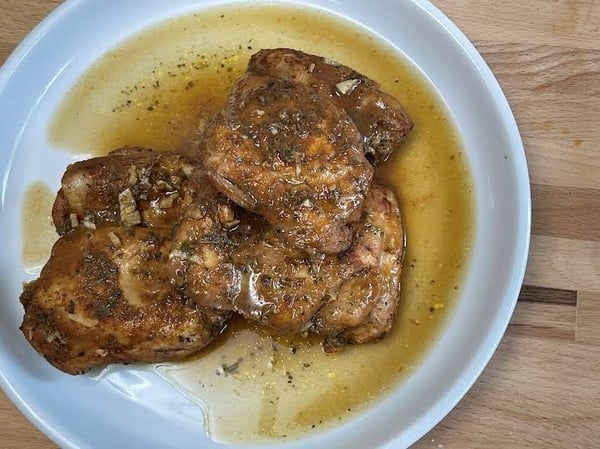 Learn more about the cuisine of Spain by joining the new travel tour with our Chef Guillermo Delavault to Basque Country, Spain this September. You can bring up these fun historical facts to impress your new travel friends!
Learn more about the cuisine of Spain by joining the new travel tour with our Chef Guillermo Delavault to Basque Country, Spain this September. You can bring up these fun historical facts to impress your new travel friends!
And if you are already familiar with adobo, I'd love to hear your thoughts! Please join The Chopping Block's private Facebook group and share your knowledge.
Get even more information and recipes with adobo in Adobo: Verb, Noun or Adjective Part 2.
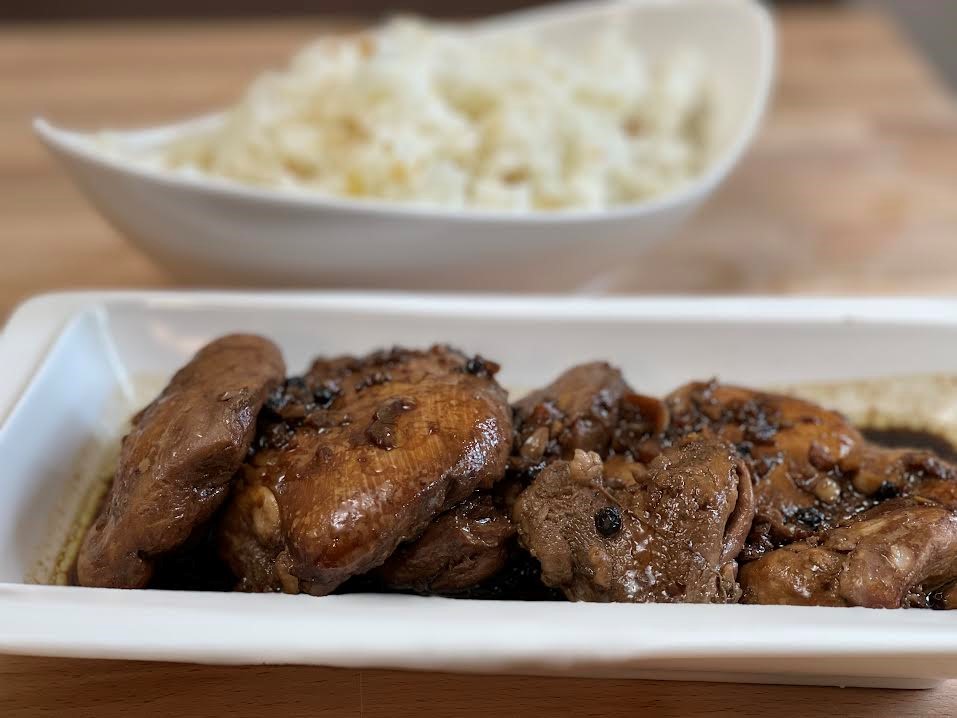
Filipino Adobo
Ingredients
- ¼ cup soy sauce
- ½ cup white vinegar
- 3 teaspoons chopped garlic
- 1 teaspoon of whole peppercorns
- 3 bay leaves
- 1.5 pounds of chicken boneless, skinless chicken thighs
Instructions
- In a glass bowl, mix soy, vinegar, garlic, peppercorns, bay leaves and chicken thighs. Make sure the chicken thighs are all coated.
- Cover and marinate for at least an hour in the refrigerator.
- Heat a large non-reactive pot over medium high heat. Heat a generous swirl, about 1 Tablespoon, of oil.
- Remove chicken from marinade and shake off excess liquid.
- Sear both sides for about 1-2 minutes. You are going for a little bit of brown. Don’t worry about it cooking all the way through because this is just for color and flavor.
- In that same pan with the chicken, add the rest of the marinade. Bring to a consistent simmer and then cover for about 25 minutes. Flip chicken after about 20 minutes.
- With the lid off, allow to continue to simmer until the sauce reaches your desired consistency. Also take a taste. If you would like the vinegar to shine through more, add a little bit more.
- Remove the bay leaves before serving.
- Serve with rice.

